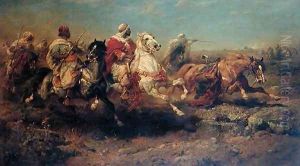Adolf Schreiyer Paintings
Adolf Schreyer was a German painter, associated with the Düsseldorf school of painting, who gained fame for his depictions of scenes from the lives of Arab horsemen in the desert landscapes of North Africa. Born on July 9, 1828, in Frankfurt am Main, Schreyer started his artistic education at the Städel art institute in his hometown and later moved to the Düsseldorf Academy, a leading art school of the time, where he studied under notable professors such as Wilhelm von Schadow.
Schreyer's early works consisted mainly of landscapes, historical subjects, and genre scenes. However, his travels to the Middle East in the 1850s had a profound impact on his artistic direction. During his sojourns in Egypt, Syria, and Algeria, Schreyer became fascinated with the local people, their customs, and the dramatic landscapes. This experience led to his signature subject matter: Arab horsemen, often depicted in the midst of battle or in scenes of everyday life in the desert.
The artist's ability to capture the movement and grace of horses, as well as his skillful rendering of the desert atmosphere, brought him international acclaim. Schreyer's works were sought after by collectors and were exhibited in major art capitals like Paris, where he moved in 1861, and where he became associated with the Barbizon school. Despite his German origins, Schreyer's success in France was notable, and he was awarded the French Legion of Honour in 1864.
Throughout his career, Schreyer continued to travel and paint, exhibiting widely and receiving numerous awards. His paintings were characterized by their dramatic compositions, vivid detail, and the romantic, almost mystical representation of the Arab way of life. Adolf Schreyer passed away on July 29, 1899, in Kronberg im Taunus. His works remain popular among collectors of Orientalist art and are held in many prominent museums and private collections worldwide.
